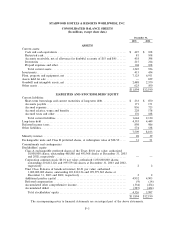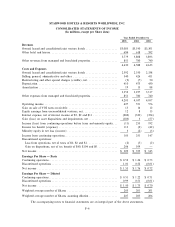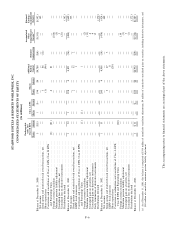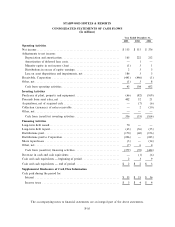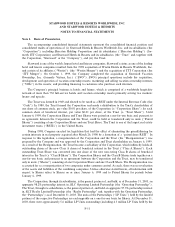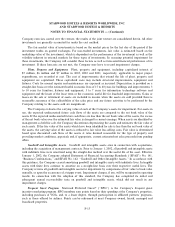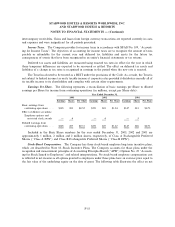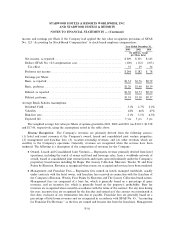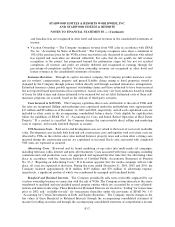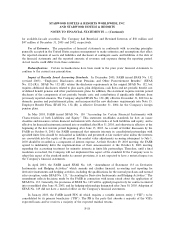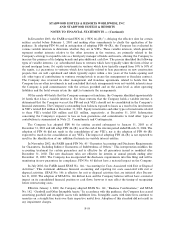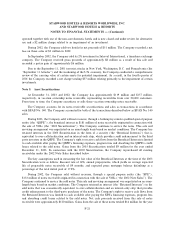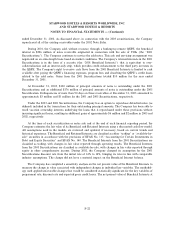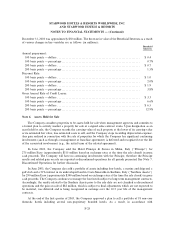Starwood 2003 Annual Report Download - page 79
Download and view the complete annual report
Please find page 79 of the 2003 Starwood annual report below. You can navigate through the pages in the report by either clicking on the pages listed below, or by using the keyword search tool below to find specific information within the annual report.STARWOOD HOTELS & RESORTS WORLDWIDE, INC.
AND STARWOOD HOTELS & RESORTS
NOTES TO FINANCIAL STATEMENTS Ì (Continued)
Company exercises control over the venture, the results of the joint venture are consolidated herein. All other
investments are generally accounted for under the cost method.
The fair market value of investments is based on the market prices for the last day of the period if the
investment trades on quoted exchanges. For non-traded investments, fair value is estimated based on the
underlying value of the investment, which is dependent on the performance of the investment as well as the
volatility inherent in external markets for these types of investments. In assessing potential impairment for
these investments, the Company will consider these factors as well as forecasted Ñnancial performance of its
investment. If these forecasts are not met, the Company may have to record impairment charges.
Plant, Property and Equipment. Plant, property and equipment, including capitalized interest of
$7 million, $6 million and $7 million in 2003, 2002 and 2001, respectively, applicable to major project
expenditures, are recorded at cost. The cost of improvements that extend the life of plant, property and
equipment are capitalized. These capitalized costs may include structural improvements, equipment and
Ñxtures. Costs for normal repairs and maintenance are expensed as incurred. Depreciation is provided on a
straight-line basis over the estimated useful economic lives of 15 to 40 years for buildings and improvements; 3
to 10 years for furniture, Ñxtures and equipment; 3 to 7 years for information technology software and
equipment and the lesser of the lease term or the economic useful life for leasehold improvements. Gains or
losses on the sale or retirement of assets are included in income when the assets are sold provided there is
reasonable assurance of the collectibility of the sales price and any future activities to be performed by the
Company relating to the assets sold are insigniÑcant.
The Company evaluates the carrying value of each of the Company's assets for impairment. For assets in
use, the expected undiscounted future cash Öows of the assets are compared to the net book value of the
assets. If the expected undiscounted future cash Öows are less than the net book value of the assets, the excess
of the net book value over the estimated fair value is charged to current earnings. When assets are identiÑed by
management as held for sale, the Company discontinues depreciating the assets and estimates the fair value of
such assets. If the fair value of the assets which have been identiÑed for sale is less than the net book value of
the assets, the carrying value of the assets is reduced to fair value less selling costs. Fair value is determined
based upon discounted cash Öows of the assets at rates deemed reasonable for the type of property and
prevailing market conditions, appraisals and, if appropriate, current estimated net sales proceeds from pending
oÅers.
Goodwill and Intangible Assets. Goodwill and intangible assets arise in connection with acquisitions,
including the acquisition of management contracts. Prior to January 1, 2002, all goodwill and intangible assets
with indeÑnite lives were amortized using the straight-line method over the useful life of the asset. EÅective
January 1, 2002, the Company adopted Statement of Financial Accounting Standards (""SFAS'') No. 141,
""Business Combinations,'' and SFAS No. 142, ""Goodwill and Other Intangible Assets.'' In accordance with
this guidance, the Company ceased amortizing goodwill and intangible assets with indeÑnite lives. Intangible
assets with Ñnite lives continue to amortize on a straight-line basis over their respective useful lives. The
Company reviews all goodwill and intangible assets for impairment by comparisons of fair value to book value
annually, or upon the occurrence of a trigger event. Impairment charges, if any, will be recognized in operating
results. In connection with the adoption of this standard, the Company has completed its initial and
subsequent annual recoverability tests on goodwill and intangible assets, which did not result in any
impairment charges.
Frequent Guest Program. Starwood Preferred Guest» (""SPG'') is the Company's frequent guest
incentive marketing program. SPG members earn points based on their spending at the Company's properties,
including purchases of VOIs, and, to a lesser degree, through participation in aÇliated partners' programs,
such as those oÅered by airlines. Points can be redeemed at most Company owned, leased, managed and
franchised properties.
F-13


